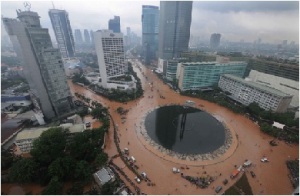Prevention was recently added to the phases of disaster management. Honestly, I was still occasionally baffled also to define whether one action includes in the category of prevention or category of mitigation. I definitely think that the basic difference, mitigation is actions or steps to reduce the impact of disaster/reduce the risk while prevention is for preventing the event to be happened/ how to avoid hazards and related disaster. I expect there may be readers of this paper can provide feedback or criticism to add to our knowledge.
We know that not all disasters, particularly natural disasters can be prevented, but the risk of lost or injury can be reduced with good evacuation plan, environmental planning, etc.
Back to the case of floods in Jakarta-Indonesia occurred in early 2013. We may still remember that at the time, the government of Indonesia in that case, the National Agency for Disaster Management (BNPB) and the Agency for the Assessment and Application of Technology (BPPT) conducted weather-modification by cloud-seeding efforts. This is an example of prevention of floods, BNPB & BPPT preventing the formation of clouds and rain outside flood-prone areas in Greater Jakarta.
Other example is relocation of local communities from landslide-prone areas. This is considered as prevention action also the government’s efforts to maintain soil structure that does not change in the event of heavy rains or earthquakes by reclamation or hard-tree planting.
Prohibition or regulations of the government to not build a home or residential in disaster-prone areas are also included in the category of prevention.
Our efforts in everyday life, such as not littering, cleaning drains / sewer in our residential area can be considered as prevention of floods and infectious diseases.
Disasters prevention is very important, and should be done continuously and sustained by all of us.
Therefore, in January 2005 during the World Conference on Disaster Reduction held in Kobe, Hyogo-Japan, 168 countries agreed to adopt a 10-year global plan for natural disaster risk reduction called the Hyogo Framework for Action. It offers guiding principles, priorities for action, and practical means for achieving disaster resilience for vulnerable communities.




